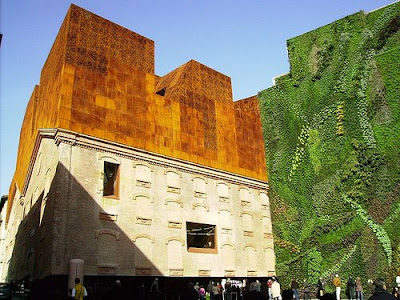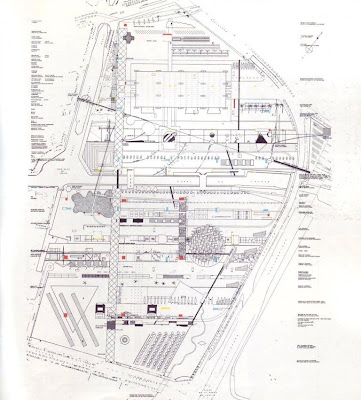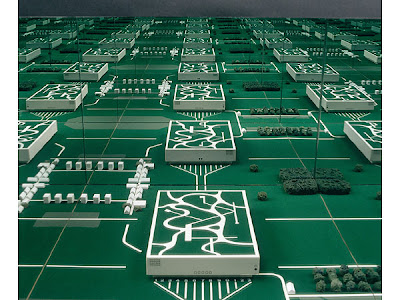‘Ecological Urbanism‘ (640 pages, Lars Müller Publishers; 1 edition (May 1, 2010) edited by Mohsen Mostafavi with Gareth Doherty) literally arrived with a thud last week, the 650 page brick like tome touching down on the front step of the house with much anticipation. Tempted as I was, a number of deadlines made me hold back a few days before cracking it open.

A bit of background… The previous 2009 conference at the GSD kicked off the overall dialogue in April of last year – I was really bummed not to be able to attend, but happy that they have access to proceedings of which are captured here in a number of informative podcasts a few months later which really captured the essence of the conference in the actual words. The book was eagerly awaited, and rumors of it’s massive size and breadth were floating around prior to it’s actual release. A preliminary snapshot from the back cover:
“While climate change, sustainable architecture, and green technologies have become increasingly topics, issues surrounding the sustainability of the city are much less developed. The premise of this book is that an ecological approach is urgently needed as an imaginative and practical method for addressing existing as well as new cities.
Ecological urbanism considers the city with multiple instruments and with a worldview that is fluid in scale and disciplinary focus. Design provides the synthetic key to connect ecology with an urbanism that is not in contradiction with its environment. … with the goal of providing a multilayered, diverse, and nuanced understanding of ecological urbanism and what it might be in the future. The promise is nothing short of a new ethics and aesthetics of the urban.”
While book jackets are supposed to strive for hyperbole, ‘a new ethics and aesthetics of the urban’ is quite a goal, even for a book of this size. The book didn’t however disappoint with a list of contributors too numerous to list in total – but spanning a range of disciplines from landscape architecture, architecture, urban design, planning, engineering, ecology, science, economics and social science to name a few. The marked mix of academic and non-academic voices was also evident and welcome – as this wasn’t just another heady treatise from the ivory tower but a combination of application spanning theory and practice.
So in this introductory post on the book I wanted to focus on the early chapter by Mohsen Mostafavi to delve into the specifics that define Ecological Urbanism. I plan on tackling some of the other portions of the book in subsequent posts, but wanted to use this as a general review of the content and introductory material. Look forward to subsequent posts loosely based on the sections of the book: Anticipate, Collaborate, Sense, Curate, Produce, Interact, Mobilize, Measure, Adapt, and Incubate… stay tuned.
Why Ecological Urbanism? Why Now?
Mohsen Mostafavi
This introductory chapter addresses the question at hand that most people think of in relation to this or any other method of urbanism. What is it, and why is it the answer. Mostafavi adds the term ‘why now?’ which maybe is an indication of the evolutionary chain of the urban (picking up on threads of landscape urbanism and ecological design in a more meaningful and applied way perhaps?)
One aspect of the argument is the somewhat dubious claim that sustainable architecture lacks sophistication and requires a lifestyle change to accompany poor design. This may have been true in the fledgling sustainability of the 1970s and 80s, but the last 15 years, with apologies to Mr. Gehry’s latest rant, has made significant contribution to better move design aware from pure art to a more balanced approach. That said, LEED and sustainability for all of it’s good – has probably been detrimental to design as a pure form, but again – we’re not creating disassociated works of art, but places for people that must exist within our ecological reality.
The second point, and the more important, is the question of scale. The scope of impacts of singular buildings limits the impact and a realization of urbanism and infrastructure becomes more vital links to true sustainability. As Mostafavi points out, “…there is a need to find alternative design approaches that will enable us to consider the large scale differently than we have done in the past.” (p.13) Apart from a building, urbanism requires work within different and complex economic, political, social, and cultural frameworks. Additionally, true integration of ecological systems requires a necessary adjustment of scale (beyond the site) and strategies (interdisciplinary) to accommodate the larger contextual framework in which they operate.

:: Extreme Weather Events: Plaquemines Parish, Louisiana, 2005 – image via The Canary Project
The integration of ecology requires one to define what they mean – in order to understand it’s connection to the urban. Mostafavi points of the inherent difference between city and ecology – but also misses a key element in modern ecology by referring to as correctly, “…an emphasis on the interrelationship of organisms and the environment…” but using an antiquated notion of the concept by mentioning that this includes, “… an emphasis that invariably excludes human intervention.” (p.17)
It is unlikely that any ecological science is still rooted in the purely non-human, as ecology seems to have embraced the need to look contextually at the impacts from humans as one of the organism within these complex relationships. While we may isolate interactions to more pure forms of biological focus, any applied ecology – in order to be considered relevant – has included humans as actors in the study for many years, such as called on by Paul Sears – and not just those subsets such as Human Ecology but discipline-wide to study and provide information to deal with human impacts on the ecosystems. In this case, perhaps ecology is even more of an appropriate vehicle, as it’s changing ideology to include the human, and work within the environments humans occupy, make ecological urbanism much more viable of a strategy.

:: Alberta Oil Sands – image via Encyclopedia of Earth
This distinction of what we mean by ecology is important – particularly when used as a the foundation for a concept. Like other ‘urbanisms‘ that get appended with a modifier, the definition of the modifier in this context important, as a word like ecology is fraught with misconceptions that could minimize the impact (like sustainable urbanism, or landscape urbanism for instance). You either make the concept impossible to define, or able to define anything.
The key to Mostafavi’s definition is the idea of action and opportunity which I think is the root of the concept, as he mentions “…we need to view the fragility of the planet and its resources as an opportunity for speculative design innovations rather than a form of technical legitimation for promoting conventional solutions… Imagining an urbanism that is other than the status quo requires a new sensibility – one that has the capacity to incorporate and accommodate the inherent conflictual conditions between ecology and urbanism. This is the territory of ecological urbanism.” (p.17)

:: Wheatfield – A Confrontation (Agnes Denes) – image via greg.org
Building on this idea of human ecology, the conversation drifts to ‘ecosophy‘ including environment, social relations, and human subjectivity, with an “…emphasis on the role that humans play in relation to ecological practices.” (p.22) No where is this more important to realize than in the design professions, making human significance, both the individual and the collective, a necessary component that should be at the heart of all design. Mostafavi concludes:
“Such a radical approach, if applied to the urban domain, would result in a form of ecological design practice that does not simply take account of the fragility of the ecosystem and the limits on resources but considers such conditions the essential basis for a new form of creative imagining.” (p.22,26)
Rather than frame this concept as all new (thankfully) it does acknowledge a combination approach of old and new practices working in tandem, “…providing a set of sensibilities and practices that can enhance our approaches to urban development…” working towards “…a cross-disciplinary and collaborative approach toward urbanism developed through the lens of ecology.” (p.26)
This brings to bear the idea of retrofitting, displayed by the Promenade Plantee in Paris, which was one of the major precedents to the modern incarnation of the High Line. Rather than demolish and replace, the retention of this is both ecological and strategic… “Given the undulating topography of the city, the promenade affords an ever-changing sectional relationship to its surroundings. As a result, the park produces a different experiences of the city compared, for example, to that of a Parisian boulevard.” (p.26,28) As an adjunct, the High Line could be even more ecological, taking the same approach but adding dimensions of more appropriate, non-ornamental vegetation that pulls from the opportunistic vegetation that colonized the derelict elevated line prior to redevelopment.

:: Promenade Plantee – image via AmericinParis
The work of rehabilitation in sides can span from building scale (such as the Caixa Forum Madrid seen below) to the more expansive post-industrial development of sites such as the fabulous Duisburg-Nord Landscape Park by Peter Latz. Mostafavi mentions “…the site acts as mnemonic device for the making of the new. The result is a type of relational approach between the terrain, the built, and the viewer’s participatory experiences.” (p. 28) Which sounds to me, a bit like an human ecological urban approach.

:: Caixa Forum Madrid – image via David Grajal
The methods of taking on these sites draw from a number of examples with have been predominately featured in landscape urbanism literature, such as competitions for Downsview Park and the OMA submittal for the Parc de la Villette competition (won by Tshcumi) – both of which feature the idea of ‘programmed surfaces’ as opposed to deterministic design. The Downsview submittals, along with the much more prominent Fresh Kills Park competition entries – venture more towards the ecological, but the OMA submission for la Villette proposal was one of the best examples of interdisciplinary alignment of architecture, landscape architecture and urbanism that led to a re-emergence of landscape and ecology in the conceptual framework of designers.
:: OMA – Parc de la Villette – image via a spatial choreography of motion
The blurring of interdiscplinary lines, at least for some of us in landscape architecture & urbanism is long-overdue, and I don’t think it will mean the breakdown of discipline-specific knowledge, but rather a better outcome for these projects. Mostafavi mentions this, but concludes the necessity versus working in isolation: “While a collaborative mode of working among various areas of design expertise is mandatory in thinking about the contemporary and future city, the transdisciplinary approach of ecological urbanism gives designers a potentially more fertile means of addressing the challenges facing the urban environment.” (p. 29) I’d take this a step further to include a much broader interdisciplinary grouping that includes not just traditional design and planning professionals, but representatives from ecological, cultural, and social sciences as core members of any team.
Shifting to scale, the idea of ecology, much like what has been posited in landscape urbanism, is that it is a much more appropriate mode of inquiry to multi-scalar investigations as opposed to singular building architecture. Urbanism in it many forms seems to embrace this, and ecology, along with a range of human-centered studies, gives us the ability to understand and “…ultimately provide the most synthetic and valuable material for alternative multi-scalar design strategies.” (p.30)
Mostafavi mentions the work of Andrea Branzi (Archizoom) and different modes of looking at urbanism, particularly one that is less based on planning determinism but on “…the fluidity of the city, its capacity to be diffuse and enzymatic in character.” (p.30) This symbiotic urbanism looks at art, agriculture, and network culture, with a focus on “…its capacity to be reversible, evolving, and provisory.” (p.30) which feeds into the idea of ecological indeterminacy in many concrete ways.
:: No Stop City (Archizoom) – image via Design History Lab
The strategic implementation of ecological urbanism is the action-oriented mode of practice – referenced in the text similarly to urban acupuncture, where: “…the interventions in and transformations of an area often have a significant impact beyond the percieved physical limits.” While ecology is one frame work, there are myriad cultural and political systems that must be incorporated – and if not purely ecological in nature – can be organized and communicated in design through the use of ecological methods. “One of the major challenges of ecological urbanism is therefore to define the conditions of governance under which it could operate that would result in a more cohesive regional planning model.” (p.30)
By taking on the specifics of urbanism (real, ugly, dirty urbanism) – requires a different idea of design. Affordable housing, use of vacant lots, code-rewriting, traffic, trash, obesity, funding, and all other issues that tend to be dismissed in Utopian ideals (or even our modern city planning proposals). We give this to municipal maintenance and operations to be dealt with, rather than thinking of these flows as systems to be accommodated during design and planning. Ecological urbanism ensures that the flows in and out of materials are addressed – and planned for in meaningful ways, building on the somewhat shallow sustainability policies that have emerged in many cities worldwide.

:: Naples Garbage Strike – image via Fire Earth
It is vital that we have examples of this working, such as those discussed in Banham’s Los Angeles: The Architecture of Four Ecologies, which takes on the city not in relation to what we should create, but rather celebrates the opportunistic methods (good and bad) that led to the creation of the metropolis. This includes understanding and expressing the flows in our cities as opportunities for cultural expression. As Mostafavi mentions the ideas of water features historic role in connecting city to water, but “… on the whole we underutilize the unexpected opportunities afforded by ecological practice as well as the location.” (p.36) I’d posit that a variety of ecological designers have been doing just this for years, but as singular sites or installations, and rarely as large scale public works (although Dreiseitl, Wenk, and others may be precedents we can explore).
:: Growing Vine Street (Buster Simpson) – image via Happy Hotelier
This introductory review is continued in Part 2.
I have been to the Caixa Forum in Madrid…it’s amazing…
Just a small point, but Mostafavi’s first name is Mohsen, not Moshen.
My bad… apologies to Mr. Mostafavi.